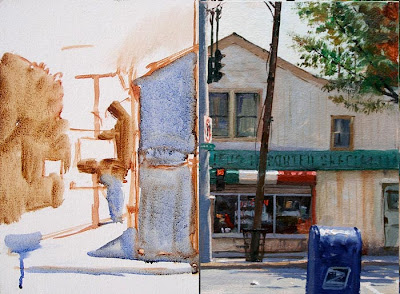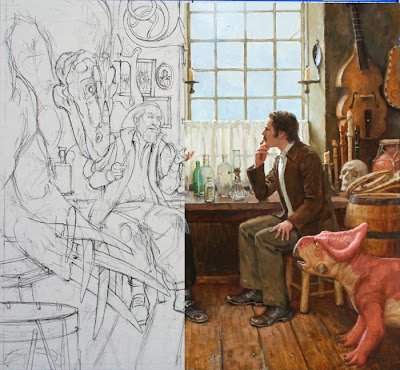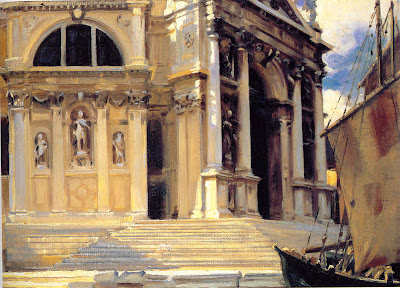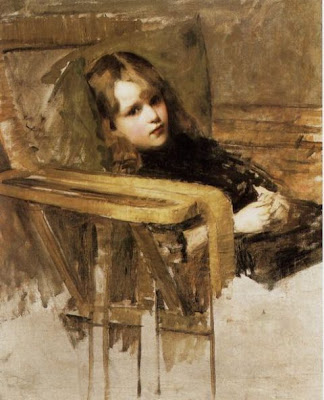“I, and some of my classmates, have been dealing with the issue of how much drawing one should do on the surface of a canvas (board, panel, paper etc) before jumping into paint. This is outside of the studies that are done beforehand and assumes that a drawing is not being transferred. Basically we've bumped into the issue of doing relatively tight, refined lay-ins in pencil and then completely losing those delicate drawings once paint is applied. Some of the teachers and students believe in "finding" the drawing with paint rather than doing a tight charcoal/graphite underdrawing. This could be related to the fact that most of our teachers here seem to advocate the thicker paint application of a certain style of Alla Prima, but I'm not sure.”
-
Dear Stephen:
I practice and recommend both extremes, depending on the picture. When I'm painting outdoors on location or doing a portrait from life, I completely find the subject with the brush (no pencil drawing at all), beginning with spots, big divisions, and measurements.
 Here’s the loose lay-in demonstrated on a 9x12 inch plein-air study, shown with the finish on the right half and the first statement on the left.
Here’s the loose lay-in demonstrated on a 9x12 inch plein-air study, shown with the finish on the right half and the first statement on the left. With other pictures, however, it's a different story. In this painting from Dinotopia: Journey to Chandara, I did a careful pencil drawings directly on the final surface, and I sometimes work out the drawing on a separate piece of paper.
With other pictures, however, it's a different story. In this painting from Dinotopia: Journey to Chandara, I did a careful pencil drawings directly on the final surface, and I sometimes work out the drawing on a separate piece of paper. With a very complex subject, like a sinking Civil War sailing ship, there's no other way I can imagine approaching it.
 Sargent, the maestro of alla prima, sometimes did very careful pencil drawings before he tried to tackle some of his Venetian studies of architecture. Richard Ormond’s new book on his Venetian work includes a reproduction of a line drawing that he did to work out the perspective of the church of Santa Maria della Salute.
Sargent, the maestro of alla prima, sometimes did very careful pencil drawings before he tried to tackle some of his Venetian studies of architecture. Richard Ormond’s new book on his Venetian work includes a reproduction of a line drawing that he did to work out the perspective of the church of Santa Maria della Salute.With an imaginary scene with a lot of figures, historical elements, mechanical forms, lettering, or anything of that kind, I recommend following something like Rockwell's method of the separate full size charcoal comprehensive, or "cartoon" as they used to call it. Of course that practice in one form or another goes back to many of the old masters.
The charcoal comprehensive pays dividends because you're not trying to solve basic problems with paint. It’s much easier to do either a line drawing or a full-on tonal study as Lovell tended to do. On top of that, it really helps to do small tonal studies and color studies.
Once you've worked out your picture you can be confident of the painting. If the drawing is "saved" in a separate tracing, you should paint boldly with no fear of covering up lines. You can always find them again if you need to.
It should be said that there are others who got great results with complex multi-figure scenes without always doing the comprehensive preliminary drawing. They bravely “found it” in the paint, and the painting shows the fascinating struggles.
 They would include Howard Pyle, Lawrence Alma-Tadema, and John William Waterhouse (above).
They would include Howard Pyle, Lawrence Alma-Tadema, and John William Waterhouse (above). I’ve also seen demos by Richard Estes and Frank McCarthy, which show a ‘find-it-in-the-paint’ approach on at least some paintings.
You can figure out these methods by looking at half-finished paintings, in strokes of overpainted elements or pentimenti that have transparentized, or in the edges of the picture normally hidden by frames.
Waterhouse from “I am a Child” website.
More about the charcoal comprehensive and preliminary drawings in my book Imaginative Realism.







7 comments:
Interesting. Your book makes clear the importance of planning, and I can see how it pays off. I quite like to make up a painting as I go along and allow a few surprises for myself. I sometimes find I draw one area then paint it, then another area and so on, as I decide what goes where. It probably seems a disorderly way of going about things but it stops things feeling too mechanical.
Thanks. This is a question I've made myself some times.
By the way... You said to paint over the lines without fear and that one can find them later. How do you exactly find the lines again once covered (sometimes they get very covered or smeared by the paint)?
Thanks again.
Kaos, I seal the drawing with acrylic matte medium, so if I really had to find the drawing again, I could use turps on a rag and rub off the oil, but I've almost never had to do that.
I prefer to "find it in the paint", but have also found that for complex compositions or picky things like elk antlers, it's easier and quicker sometimes to start with a fairly tight pencil drawing on the canvas.
I do a grid transfer from a smaller, finished drawing using a hard pencil and, re-state the drawing with a brush, correcting as I go and then I'm off and running.
Is it me or does the oil sitting on acrylic matte medium scratch off pretty easily?
Maybe I'm applying it too thick.
=s=
Great post James.
Shane, I've never had any problem with adhesion of oil over acrylic. I put on the matte medium very thinly, usually squeegeeing it off with a piece of mat board.
Post a Comment